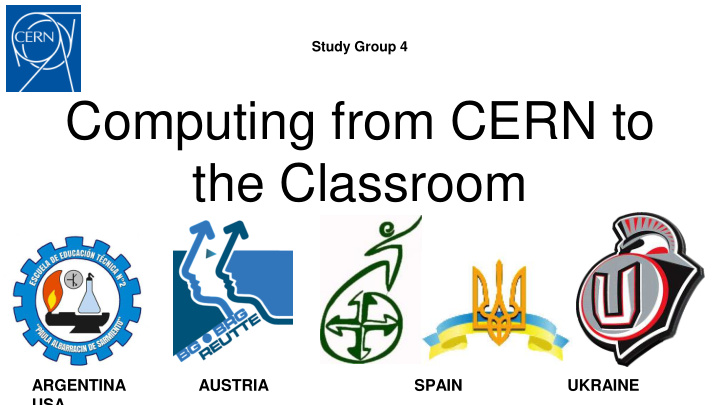



Study Group 4 Computing from CERN to the Classroom ARGENTINA AUSTRIA SPAIN UKRAINE USA
What is the path of the data? 2
Data Produced at CERN 3
The Worldwide LHC Computing Grid 4
Resources for computing at CERN CERN Open Data program: http://opendata.cern.ch/ CERN Open Lab Program: http://information-technology.web.cern.ch/about/organisation/cern-openlab CERN Data Centre Website: https://home.cern/about/computing CERN Information Technology: http://monit-grafana-open.cern.ch/d/000000884/it-overview?orgId=16 5
Computer Related Activities for the Classroom Physics - size of data sets Physics - size of CERN data compared to books in print Chemistry - Minecraft Education: Chemistry Computer Technology - Bandwidth, Data Storage and Processing Power comparison 6 Photo: Eielson Air Base
Coffee Cooling: Activity #1 Which cools faster? 7
Coffee Cooling: Activity #1 Which cools faster? Collect data & discuss size 8
Coffee Cooling: Activity #1 Which cools faster? Collect data & discuss size How can we improve? 9
Coffee Cooling: Activity #1 Which cools faster? Collect data & discuss size How can we improve? Could we scale this to the size of CERN data? 10
Books & CERN: Activity #2 CERN produces massive amounts of data each second. ~ 25 Petabyte / year ~ 68 Terabyte / day Photo by Janko Ferlic from Pexels 11
Books & CERN: Activity #2 CERN produces massive amounts of data each second. ~ 25 Petabyte / year ~ 68 Terabyte / day What would a visual of the number of books it would take to have the same amount of data as CERN in one day? Photo by Janko Ferlic from Pexels 12
Books & CERN: Activity #2 CERN produces massive amounts of data each second. ~ 25 Petabyte / year ~ 68 Terabyte / day What would a visual of the number of books it would take to have the same amount of data as CERN in one day? Photo by Janko Ferlic from Pexels 13 ~ 47Tb for all books in history
Chemistry: Activity #3 14
Chemistry: Activity #3 Step 1: Students use the tool in Minecraft Element Constructor to study the atomic structure in a creative way. Step 2: Students investigate Standard Model of particle physics by CERN, LHC and Particle Adventure. It starts with an accurate description of the subatomic structure of the matter showing an atomic model with electron and quarks. Then students create model of atomic structure by Blender Step 3: Lectures about particle physics, detectors, accelerations and computing at CERN. Skype -a- scientist. Step 4: Knowing the computing power to model an atom, discuss the computing bandwidth required to model one second of collisions and the number of particles involved and about computing. Used ISOLDE Yield Database shown in Fig 2 , find produced isotopes 5 elements independent on the target. Find production details: target density, ion source on Target and Separators page. This also greatly reinforces the abilities of students of chemistry to think through the immense quantity of data. 15
Description of activities: Activity #4 To analyze 3 aspects of computing and compare to the resources that students Network speed transfer has at home or school ● Network speed transfer ● Storage capacity ● Processing power Teachers can start with “Computing at - CERN” talk reference or can use the our report Introduction as reference. 16
Data Center Comparison: Activity #4 ● Network speed transfer Students will compare some of their devices´s transmission speed with the transfer rate Network speed transfer reached at CERN. (cell phones,WiFi at home, etc) ● Storage capacity Students will study some storage units they use, such as pendrives, hard disks, and compare them with the tape storage system used in the Datacenter. (deal with units, TB...) ● Processing power Comparison between the processors and cores running in the GRID for moving the data to storage, with the processing power of a desktop computer or an iPhone. 17
Take home message and conclusions: - Computing@CERN involves all main experiments. - Requiere a lots of combined power. - We offer a set of four activities to to at claseroom. 18
Thank you! Questions? 19
Reference All pictures referenced are from Xavier Espinal’s presentation to ITW 2018 at: https://indico.cern.ch/event/658853/contributions/2995845/attachments/1700030/2 737557/ITW-CERN-Computing-2018.pdf 20
Recommend
More recommend